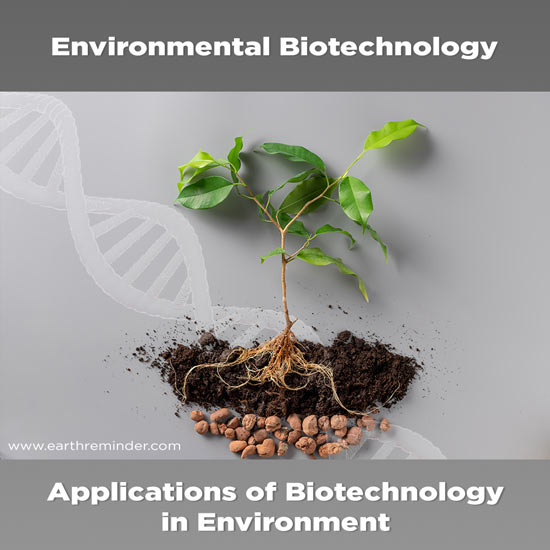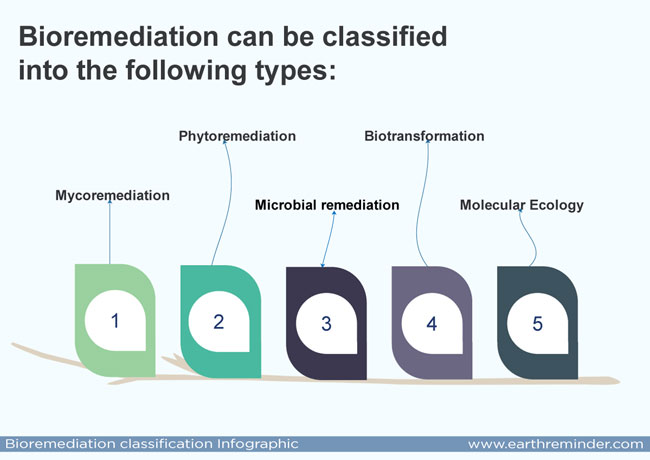Applications of Biotechnology in Environment
Environment and biotechnology: both are crucial topics in today’s life. So, a branch of biotechnology has been introduced to protect our environment, known as environmental biotechnology.

We can also define Environmental biotechnology as the branch of biotechnology that includes environmental issues such as the removal of pollution, renewable energy production, or Biomass production by using biological processes.
Because of the Rapid growth of industrialization and urbanization, our environment is facing threatening problems. These are such as the depletion of natural resources, pollution, and lots more. By using biotechnological applications, these problems can be solved efficiently.
Environmental biotechnology is not a new field of research; it has incorporated several previously used methods and technologies such as composting, wastewater treatment and so on. In the beginning stage, it has developed from chemical engineering. Still, afterwards, other fields like biochemistry, ecological engineering, environmental microbiology, Molecular Biology, and ecology are also deeply involved in its growth.
For the advancement of human activities in industry, transport, agriculture, domestic space, etc. the pollution of air, water, and soil has increased. Some distant studies have shown that the biotechnological applications can remove or degrade a few of these pollutants.
Table of Contents
Applications of Biotechnology in Environment
The continuous development of humans and other living beings without harming our environment is necessary. The world’s population is increasing day by day. That shows the continuous usage of natural resources. As a result of which these sources are depleting rapidly. Biotechnology has played a significant role in protecting those assets.
Environmental biotechnology has several applications. Some of them are:
Biomarkers
It is an application of biotechnology in the environment that responds to the chemicals to Measure the effect of pollution caused.
We can define Biomarkers as biological markers, which help to detect the relationship or correlation between the oil and its sources.
A biomarker may change biological responses starting from the molecular level through cellular and physiological responses or by behavioural changes, which may be associated with exposure to a toxic effect of environmental chemicals.
The recent development in biological science and biotechnology inventions led to the development of many sensitive validate biomarkers. By their application, we can get results and sensitivity to adverse effects on terrestrial and aquatic pollution.
Different types of biomarkers can be used either by in-vivo or in-vitro techniques.
Biosensor
Biosensors can be defined as the analytical devices incorporating a biological material.
These are used for sensitive organic elements such as tissues, microbes, organelles, cell receptors, enzymes, antibodies, nucleic acids, and natural products.
Biosensor electronic readers are manufactured by Palmsens, Gwent biotechnology systems, and Rapid labs. Recent uses of biosensors include the detection of levels of toxins in an ecosystem and airborne pathogens (i.e., Anthrax) and also monitoring glucose levels in the blood.
A glucometer is an example of a biosensor. It is used to determine the approximate concentration of glucose in the blood. Biosensors also have a significant role in the food industry. Optics coated with antibodies used to detect food toxins and pathogens and thus known as food biosensors.
Also, researchers use some other sensors, like DNA biosensors and microbial biosensors. We can define DNA biosensors as complicated mini machines which comprise sensing elements such as micro-lasers and a signal generator. We can further use them for medical diagnostics, forensic science, agriculture, or even environmental clean-up efforts.
Researchers have created many microbial biosensors by using microbial engineering, for example, arsenic biosensors that can detect arsenic. We can also find pollutants in the sample by using bacteria.
Biofuels
Biofuels usually applied in the industrial, domestic, and space sectors. In today’s life, the need for Clean Energy has increased. By using biofuel, we can preserve natural resources, as it is an alternative to fossil fuels.
Biomass is a simple organic matter—for example, kernels of corn, mats of algae, and stalks of sugarcane. So, these are the substances we use to derive biofuels.
There are three types of biofuels: first-generation biofuels, second-generation biofuels, and third-generation biofuels.
First-generation biofuels include bio alcohol (corn, sugarcane), biodiesel, syngas, and biogas. Examples of second-generation biofuels are cellulosic, biofuels, bio-hydrogen, and bioethanol. Algae fuel comes under third-generation biofuels.
Bioremediation Environmental Biotechnology Application
Bioremediation comes from two words that are ‘bio’ and ‘remediate.’ The term ‘remediate’ means solving a problem. In Bioremediation, we use biological entities for solving environmental issues such as contaminated soil or groundwater and much more.
Through the bioremediation process, we can clean the hazardous substances up into non-toxic compounds. For this cleaning up process, we mostly use microbes. In this process, fertilizers, oxygen, and other conditions are provided to the pollution-eating microorganisms to encourage their growth.
These microbes are at their exponential growth phase, and thus, they break down the organic pollutants at a faster rate. Further, we can use Bioremediation to clean up oil spills.
Further, it takes place through two methods. In the first type, we use several methods to increase the growth of microorganisms in the pollution area. These microbes are already present in the contaminated site. In the second type, which is not common, we add specialist microbes to degrade the contaminants.
Further, the bioremediation process is safer and cheaper than incineration of the contaminated minerals.
Bioremediation can be classified into the following types:

-
Mycoremediation
mycoremediation is a process in which we use fungi for the operation of decontamination.
When the fungal mycelia are used in the process of Bioremediation, it is called mycoremediation.
In the ecosystem, the primary function of fungus is to break the organic substances into much smaller and simpler materials.
Hence, the mycelium secretes extracellular enzymes and acids that help in breaking down substances such as lignin and cellulose. These are the building blocks of plant fibers.
The principal aim of the mycoremediation is to target the appropriate fungal species for a specific pollutant.
-
Phytoremediation
It is a type of Bioremediation in which we use the green plants and microorganisms directly to balance or decline the contaminated soil, sludge, sediments, surface water, or groundwater.
Phytoremediation is the combination of two words such as phyto and remedian. According to the ancient Greek term, the word ‘Phyto’ means plants, and remedian means restoring balance.
Phytoremediation shows up a path to deal with environmental problems with plants. Thus, it has many polluted elements, including contaminated soil, water, and air, and the plants can eliminate metals, pesticides, solvents, explosives, and crude oil.
- Microbial remediation
It is when we use microorganisms to degrade organic contaminants and bind the use of metals in less bioavailable form.
We can process microbial remediation in both aerobic and anaerobic conditions. So, in aerobic conditions, microbes use oxygen to perform their work. In the presence of oxygen, microbes can give the maximum amount of water and carbon through the conversion of contaminants and toxins.
Hence, when the oxygen is absent, microbes must work without oxygen. In this condition, the chemical compounds present in the soil helps the anaerobic microbes to perform efficiently.
-
Biotransformation
Biotransformation is a process of chemical change of the complex compound to a pure, non-toxic form.
We use this process in the manufacturing sector, for converting toxic substances into bioproducts. It also includes the process by which molecules change from one form to another within an organism.
We often connect biotransformation with the change (increase, decrease, or little change) in the pharmacologic activity. It refers mainly to drugs and other xenobiotics.
-
Molecular Ecology
It is a field of evolutionary biology concerned with applying different fields like molecular population genetics, molecular phylogenetic, and, more recently, genomics to traditional ecological questions. (e.g., species diagnosis, conservation and assessment of biodiversity, species-area relationships, and many behavioral ecologies).
DNA fingerprinting is a biological technique, and we use it to understand the aspects of nature in a better way.
The technique helps to observe different populations’ biodiversity to confirm that they are not at risk of being extinct (cheetah and polar bears).
We can also use this technique to recognize newly invented species. Also, we can use this to map the evolutionary development of different families of animals (recently horses and whales) in a better way.
Benefits of Environmental Biotechnology:
Applications of biotechnology in environment has many advantages, some of them are listed below:
- The significant benefits of environmental biotechnology are that it helps us to make our environment safer and cleaner for further use.
- Further, it helps the organisms and therefore; the engineers seek helpful ways for adapting to the changes in the environment and keep it clean.
- Environmental biotechnology helps us to avoid hazardous pollutants and wastes, which can affect the natural resources and our environment.
- We must do social development in such a way that it helps us to not only protect our environment but also for further development.
- Environmental biotechnology also has a major role in the removal of pollutants.
- Scientists and environmentalists have an advantage because of this field’s development to convert the waste to reusable products.
- The applications of environmental biotechnology have become a beneficial factor for our environment. The applications include genomics, proteomics, bioinformatics, sequencing, and imaging techniques which provide a large quantity of information and alternative methods to improve and protect our environment.
If you like this article, do share it with the science and bio students and comment below if you want to addon anything useful.
References:
- nature.com – “Researches on Environmental Biotechnology.”
- www.researchgate.net – “Khodadadi, Ehsan. (2014). A review of applications of biotechnology in the environment. International Journal of Farming and Allied Sciences. 3. 1319-1325.”